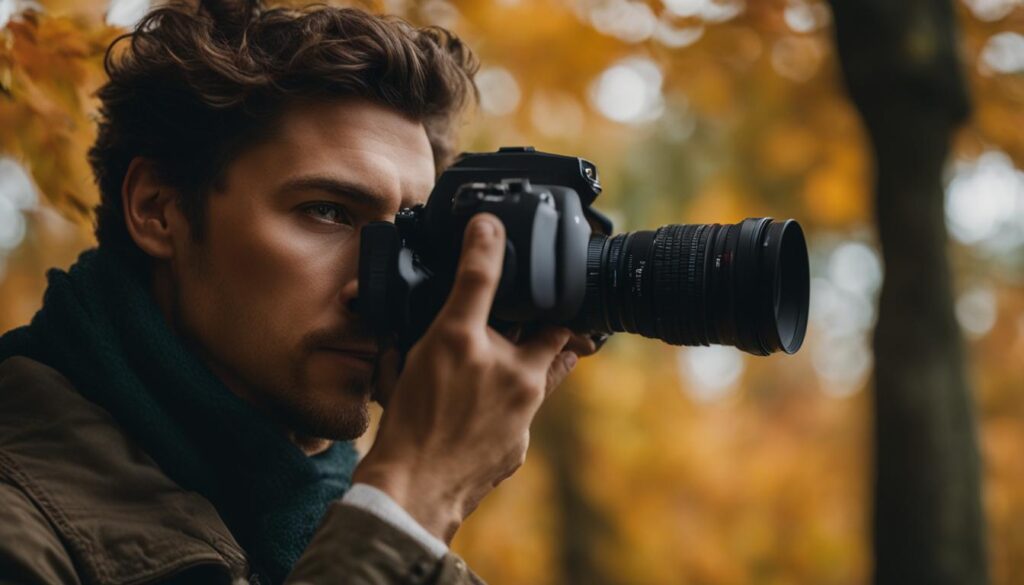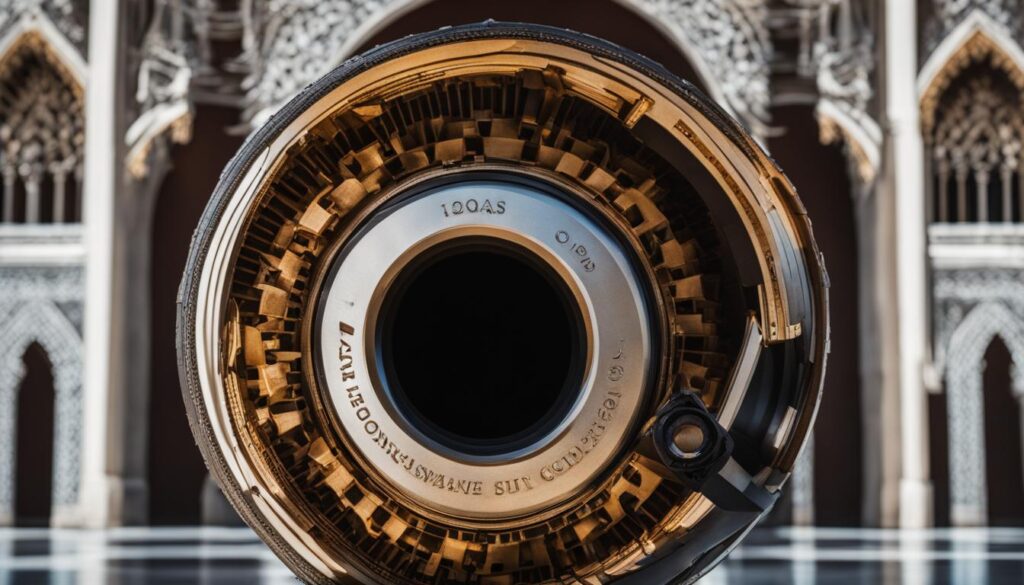We may earn money or products from the companies mentioned in this post.
Portrait photography is a beautiful and captivating art form that requires a combination of technical skill and creative vision. If you’re a beginner, you may feel overwhelmed with all the techniques and equipment involved in portrait photography. However, with the right guidance and practice, you can master the skills needed to capture stunning portraits that will leave a lasting impression.
In this comprehensive guide, we will explore various portrait photography techniques that will help beginners like you enhance your skills and take your portraits to the next level. We will cover the basics of portrait photography, including camera settings and composition, as well as advanced techniques like lighting and editing. Whether you’re shooting in a studio or outdoors, this guide will help you create beautiful and professional-looking portraits that you’ll be proud to show off.
Key Takeaways:
- Portrait photography requires a combination of technical skill and creative vision
- Beginners should focus on mastering basic techniques like camera settings and composition before moving on to advanced techniques
- Lighting plays a vital role in portrait photography and can dramatically change the mood and feel of an image
- Editing is an essential step in the portrait photography process, allowing you to refine and enhance your images further
- With practice and perseverance, anyone can master portrait photography and create stunning and memorable portraits
Understanding the Basics of Portrait Photography
Portrait photography can be an incredibly rewarding form of photography, capturing the essence of a person’s character or mood. Whether you’re photographing friends and family or taking portraits professionally, understanding the basics of portrait photography is essential.
Camera Settings for Portrait Photography
The first step in capturing stunning portraits is to set up your camera correctly. There are a few essential camera settings you should consider when taking portraits:
| Setting | Recommendation |
|---|---|
| Aperture | Use a wide aperture, around f/2.8 to f/5.6, to create a shallow depth of field and blur the background. |
| Shutter Speed | Use a shutter speed of at least 1/125 to avoid camera shake and motion blur. |
| ISO | Set your ISO to the lowest possible value to avoid noise and maintain image quality. |
| Focal Length | Use a focal length of 50mm or above for a more flattering perspective and to avoid distortion in the image. |
The Fundamentals of Portrait Photography
There are several fundamental concepts to keep in mind when taking portraits:
- Focus on the eyes: The eyes are the most important part of any portrait, so make sure they are in sharp focus.
- Choose the right backdrop: The backdrop can significantly impact the mood and tone of a portrait. Consider using a neutral backdrop or a setting that complements the subject.
- Experiment with composition: Experiment with different angles, framing, and posing to create unique and striking portraits that stand out.
By keeping these fundamentals in mind and understanding the essential camera settings for portrait photography, you’ll be well on your way to capturing stunning portraits.
Posing Techniques for Stunning Portraits
Posing is a crucial aspect of portrait photography, and it can greatly impact the overall look and feel of the image. A well-posed subject can make all the difference in creating a beautiful and engaging portrait. Here are some posing techniques for portrait photography:
- Encourage natural poses: Your subjects should feel comfortable and relaxed when posing. Encourage them to sit or stand in a natural, relaxed position. Avoid stiff, forced poses that can look awkward.
- Use posing cues: Provide your subjects with cues to help them pose naturally. For example, ask them to lean slightly forward or to turn their heads slightly to the side.
- Pay attention to body language: Body language is an important aspect of posing. Encourage your subjects to relax their shoulders and avoid crossing their arms or legs, which can create a closed-off posture.
It’s also important to consider the subject’s body type and features when posing. Here are some tips to keep in mind:
| Subject | Pose Tips |
|---|---|
| Fuller Figure | Avoid standing poses; have them sit or recline instead. Try posing at an angle to slim the figure. |
| Thin Figure | Encourage standing poses, with weight on one foot and a slight bend in the other leg to create curves and add dimension. |
| Round Face | Avoid straight-on shots; shoot from a higher angle to slim the face or from a lower angle to add height. |
| Square Face | Encourage the subject to tilt their head to one side to soften the jawline and add a more flattering angle. |
Finally, communication is key when posing your subjects. Be clear and concise in your instructions, and provide positive feedback to help them feel confident and at ease. With these posing techniques and tips in mind, you’ll be well on your way to creating stunning and engaging portraits!
Mastering Lighting Techniques for Portraits
Lighting is an essential component of portrait photography and can significantly impact the mood and atmosphere of your images. Utilizing lighting techniques can help enhance your subject’s features and create a captivating image that stands out. In this section, we will explore different lighting techniques, including natural light, studio lighting setups, and how to use modifiers to control and enhance the lighting for stunning portraits.
Natural Light Portrait Photography Techniques
Natural light can produce stunning portrait images when used effectively. To take advantage of natural light, it is essential to pay attention to the time of day and the direction of light. Set up your subject facing a window or open door to take advantage of natural light coming in. Avoid harsh midday sun and opt for softer light during the golden hours of sunrise and sunset.
Another natural light technique is to use reflectors, which help bounce light back onto your subject and create an even, flattering look. Place the reflector opposite to the light source, so it bounces light onto the shadow side of your subject’s face.
Studio Lighting Setups
Using studio lighting can give you more control over your lighting and help you achieve consistent results. A basic studio lighting setup includes a key light, fill light, and background light. The key light is the main source of light, while the fill light helps fill in shadows and create a more even look. The background light illuminates the background, making it appear brighter and more prominent.
Modifiers, such as softboxes, umbrellas, and reflectors, can help control the direction and quality of the light. Softboxes create a softer, more diffused light, while umbrellas create a broader, more even light. Reflectors help bounce light and create a more flattering look.
Combining Natural and Studio Lighting Techniques
You can combine natural and studio lighting techniques to create a more dynamic and visually engaging portrait. For example, you can use natural light as a key light and add a fill light to even out the shadows. Or, you can use studio lighting as a key light and add a reflector to bounce light back onto the shadow side of your subject’s face.
Experiment with different lighting setups and techniques to find the ones that work best for your style and subject. Remember, lighting is a crucial aspect of portrait photography, so take the time to learn and perfect your lighting techniques to capture stunning portraits.
Composition Techniques to Enhance Your Portraits
Composition is a critical aspect of portrait photography, as it can make or break the overall impact of your image. Utilizing composition techniques can help you create visually pleasing portraits that capture the viewer’s attention and convey the desired message.
The Rule of Thirds
The rule of thirds is a fundamental composition technique that involves dividing your image into a 3×3 grid and placing your subject at the intersection of the lines. This technique creates balance and visual interest, leading the viewer’s eye towards the subject and adding depth to the image.
Leading Lines
Leading lines are lines within the image that lead the viewer’s eye towards the subject. These lines can be actual lines such as a road or a fence or implied lines such as the gaze of a subject. Including leading lines in your images can create direction and movement, making the photo more dynamic and interesting.
Framing
Framing is a composition technique that involves using elements within the image to frame the subject. This can include natural elements such as trees or man-made elements such as windows or doors. Framing creates depth and dimension, drawing the viewer’s attention to the subject.
Creating Depth
Creating depth in your image can add a sense of realism and dimension, making the photo more engaging for the viewer. The use of foreground, middle ground, and background elements can help create depth and lead the viewer’s eye towards the subject.
Using Negative Space
Negative space is the area around the subject that is left blank or unoccupied. Utilizing negative space can create a minimalist and dramatic effect, drawing attention to the subject and eliminating distractions.
By incorporating these composition techniques into your portrait photography, you can improve your images’ aesthetic quality and convey a more powerful message to your viewers. Remember to experiment with different techniques and find what works best for your individual style and vision.
Editing Techniques for Polished Portraits
After capturing your portrait images, the next step is to refine and enhance them using editing techniques. Editing can help you achieve a professional and polished look by adjusting colors, tones, and other elements. Here are some effective editing techniques for portrait photography:
- Color Correction: Adjusting color balance and saturation can help make your portraits more vibrant and visually appealing. Use the color correction tools in your editing software to fine-tune the colors and create a cohesive look.
- Skin Retouching: Skin retouching is a delicate process that requires careful attention to detail. Use the spot healing brush tool to remove blemishes and other imperfections, or use frequency separation to smooth out the skin texture while still maintaining a natural look.
- Tonal Adjustments: Adjusting the contrast and brightness can help emphasize the features of your subject and create a dynamic look. Use tools such as curves or levels to adjust the tonal values and ensure a well-balanced exposure.
- Cropping: Cropping your images can help improve the composition and remove distracting elements. Use the crop tool to adjust the framing and create a more visually appealing image.
- Selective Editing: Use selective editing tools such as adjustment brushes or masks to make specific adjustments to certain areas of the image. This can help draw attention to the subject and create a more polished look.
When editing your images, it’s important to maintain a natural look while still achieving a professional finish. Avoid over-processing your images or creating artificial effects that can detract from the subject’s natural beauty.
Tip: When editing your portrait images, it’s always a good idea to work on a copy of the original file. This way, you can always go back to the original image if needed and avoid making irreversible changes.
Professional Portrait Photography Tips
As you continue to develop your portrait photography skills, implementing some of these professional portrait photography techniques and creative portrait photography tips will help you take your portrait photography to the next level.
1. Work with Different Lenses
Experimenting with different lenses can add variety and creativity to your portraits. Wide-angle lenses can capture environmental portraits, while telephoto lenses can create a shallow depth of field and isolate your subject from the background.
2. Explore Alternative Angles
Don’t be afraid to change up your perspective to create unique and unexpected portraits. Consider shooting from above or below your subject or using reflections to add interest to your shots.
3. Create a Connection with Your Subject
Building a rapport with your subject can help them feel more comfortable and natural in front of the camera. Engage in conversation, offer compliments, and provide clear direction to create a relaxed and enjoyable photoshoot experience.
4. Utilize Props and Backgrounds Creatively
Using props and backgrounds creatively can add personality and depth to your portraits. Consider incorporating items that are meaningful to your subject or using textured or patterned backgrounds to create visual interest.
5. Be Prepared for the Unexpected
Even the most well-planned photoshoots can have unexpected challenges. Always be prepared with backup equipment, extra batteries and memory cards, and a willingness to adapt to changing circumstances.
6. Practice, Practice, Practice
Like any skill, mastering portrait photography takes practice. Keep shooting, experimenting with new techniques and styles to develop your unique vision and style.
Conclusion
By implementing the portrait photography techniques discussed in this guide, you can elevate your skills and capture stunning portraits that make a lasting impression. Remember to always consider the basics, such as camera settings and composition, to create a solid foundation for your portraits. From there, explore and experiment with posing, lighting, and editing techniques to develop your unique style and artistic vision.
Don’t be afraid to try new things and take creative risks to create memorable images that capture the essence of your subjects. As you continue to practice and hone your craft, you will develop a keen eye for detail and the ability to capture stunning portraits in any setting.
Thank you for reading this guide on portrait photography techniques, we hope that you found it insightful and informative.
FAQ
What are some important camera settings for portrait photography?
When shooting portraits, it is recommended to use a wide aperture (low f-stop number) to create a shallow depth of field and achieve a blurred background. Additionally, using a lower ISO setting will help reduce noise in your images, while a moderate shutter speed will prevent motion blur.
How can I make my portrait subjects feel comfortable in front of the camera?
Establishing a rapport with your subjects is crucial to make them feel at ease during a portrait session. Engage in conversation, provide clear direction, and offer positive feedback to build their confidence. Creating a relaxed and friendly environment will help them feel more comfortable and natural in front of the camera.
What are some popular lighting techniques for portrait photography?
There are several lighting techniques you can use for portrait photography. Natural light can create soft and flattering illumination, while studio lighting setups give you more control over the light direction and intensity. You can also use reflectors and diffusers to modify and enhance the lighting conditions.
How can I enhance the composition of my portrait photos?
To improve the composition of your portraits, consider using the rule of thirds to create a balanced and visually appealing image. Experiment with leading lines or framing techniques to draw attention to your subject. Additionally, creating depth by incorporating foreground and background elements can add interest and dimension to your photos.
What editing techniques can I use to enhance my portrait photos?
During the editing process, you can adjust the color balance, saturation, and contrast to achieve the desired look for your portraits. Skin retouching is also commonly used to smooth out imperfections, while dodging and burning techniques can help emphasize certain areas and create a more polished and professional result.
What are some additional tips for capturing professional portraits?
Utilizing different lenses can provide you with varying perspectives and creative possibilities. Experimenting with alternative angles and compositions can add uniqueness to your portraits. Building a connection with your subject by establishing trust and rapport will result in more authentic and compelling images. Additionally, incorporating props and backgrounds creatively can help tell a story or add visual interest to your portraits.
Affiliate Disclosure: This post may contain affiliate links. If you purchase through our link, we may receive a small commission, but at no additional cost to you. For more information, please see our Disclosure statement.



